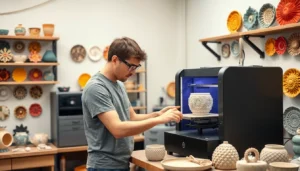Table of Contents
ToggleIn the world of 3D printing, PETG is like that friend who always shows up to the party with snacks—reliable, versatile, and ready to impress. This thermoplastic copolyester has taken the maker community by storm, offering a perfect blend of strength, flexibility, and ease of use. If you’re tired of prints that warp faster than a bad magician’s trick, it’s time to give PETG a shot.
Overview of PETG 3D Printing
PETG, known for its excellent balance of strength and flexibility, serves as an ideal material for various 3D printing applications. Versatile in nature, it accommodates a wide range of projects, from functional parts to prototypes. Many users appreciate PETG’s resistance to impact, making it suitable for items requiring durability.
Ease of printing defines PETG’s appeal, as it adheres well to build surfaces and significantly reduces the risk of warping. Printed parts maintain structural integrity even under stress. Combining transparency with strength, PETG can produce visually appealing models while also being functional.
Working with PETG involves specific settings; optimal temperature ranges typically lie between 220°C and 260°C. Proper cooling and bed temperatures enhance print quality, contributing to a smoother finish. Utilizing a direct drive extruder, users experience fewer feeding issues, which further promotes successful prints.
Post-processing opportunities enhance PETG’s potential. Common methods include sanding and vapor smoothing, allowing for improved aesthetics and a refined surface finish. Many found that painting PETG parts with specific paints increases visual appeal and opens avenues for creativity.
In terms of applications, PETG sees frequent use in industries like automotive, healthcare, and consumer products. Designers favor it for creating functional prototypes and complex geometries due to its ease of modification. Overall, PETG stands out as a reliable choice, captivating both hobbyists and professionals in the 3D printing community.
Benefits of PETG 3D Printing
PETG offers numerous advantages that make it an excellent choice for 3D printing. Its properties cater to a wide range of applications, ensuring high satisfaction among users.
Durability and Strength
Durability characterizes PETG, providing resistance to impact and stress. This strength allows parts to withstand demanding conditions, making it suitable for functional items. Users often prefer PETG for prototyping because it mimics the behavior of finished products. Those needing strong mechanical properties find PETG an ideal choice. This thermoplastic copolyester maintains its integrity even in challenging environments, reducing the risk of breakage.
Chemical Resistance
Chemical resistance stands out as a significant advantage of PETG. It shows effectiveness against various substances, including acids and bases. This resistance ensures that printed parts can endure exposure without degrading. Many industries, such as automotive and medical, benefit from this property. Users appreciate the ability to use PETG components in environments where other materials might fail, providing long-lasting performance.
Ease of Use
Ease of use is another key benefit of PETG 3D printing. The material adheres well to print surfaces, reducing issues like warping. Users often experience fewer failures during printing, contributing to a smoother workflow. Optimal print settings include moderate temperature ranges, which enhance compatibility with most printers. Additionally, PETG allows for straightforward post-processing techniques, like sanding and painting, offering flexibility in finishing parts.
Applications of PETG 3D Printing
PETG 3D printing has diverse applications due to its unique properties, making it a preferred choice in various industries.
Prototyping
Prototyping stands out as a primary application of PETG. Designers create functional prototypes, taking advantage of material properties like flexibility and strength. It allows for accurate representation of end products. Rapid iteration becomes feasible due to the quicker print times. Companies in automotive and consumer goods often rely on PETG to test designs effectively while minimizing material costs. Prototyping with PETG supports designers in making informed decisions early in the development process.
Final Products
Final products benefit significantly from PETG’s durability and chemical resistance. These products find their way into industries such as automotive and healthcare, where part integrity is critical. Items like custom enclosures, brackets, and fixtures highlight PETG’s versatility in real-world applications. Users appreciate its ability to withstand stress and functionality without compromising aesthetics. Printing final products with PETG accelerates production timelines while ensuring high performance, making it an ideal choice for professionals seeking reliable outcomes.
Comparison with Other Materials
Understanding how PETG compares with other 3D printing materials helps users make informed choices for their projects.
PETG vs. PLA
PETG and PLA serve different needs in 3D printing. While PLA offers ease of use and excellent print quality, it lacks PETG’s impact resistance and durability. PETG exhibits higher strength and flexibility, making it suitable for functional parts. Additionally, PETG shows better performance in challenging environments due to its chemical resistance. Factors like temperature and mechanical stress further differentiate the two; PLA can deform under heat whereas PETG maintains stability. In terms of aesthetics, PLA can provide a finer finish, but PETG allows for smoother surfaces post-processing. Therefore, enthusiasts should select based on specific project requirements, weighing the strengths and weaknesses of each material.
PETG vs. ABS
PETG and ABS contrast significantly in various aspects. ABS provides higher temperatures and better durability than standard plastics, yet it struggles with warping and requires careful handling. On the other hand, PETG offers a balance between strength and ease of printing, minimizing warping issues. Users admire the simplicity of printing PETG, as it adheres well to surfaces without the need for a heated bed. Both materials possess chemical resistance; however, PETG excels in this area, particularly in automotive and medical applications. Overall, the choice between PETG and ABS hinges on print requirements, environmental conditions, and desired structural integrity.
PETG 3D printing offers a unique blend of strength flexibility and ease of use that appeals to both hobbyists and professionals. Its durability and chemical resistance make it a standout choice for various applications from prototyping to final products. With optimal printing settings and effective post-processing techniques users can achieve high-quality results that meet demanding project requirements. As the 3D printing landscape continues to evolve PETG remains a reliable material that enhances productivity and performance in diverse industries. Embracing PETG can lead to innovative designs and efficient workflows ensuring it stays a favorite among creators.






